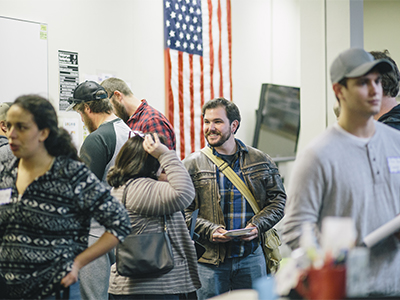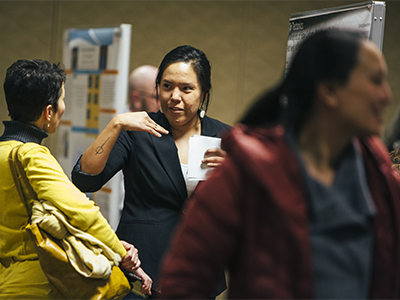Access
Land-grant universities were established by Congress in 1862 with the explicit intent to educate the sons and daughters of the industrial classes. MSU continues to fulfill that intent, believing that education serves society as a whole through job creation, stronger civic participation and higher incomes as well as a reduction in crime, health care expenses, and unemployment – the societal costs borne by a less educated populace. MSU does not turn away qualified Montanans and will continue to provide access to a quality education for all students to improve the state and the wellbeing of its citizens.
Goal: Montana State University is committed to widening access to higher education and ensuring equality of opportunity for all.
Objective A.1: Educate more students while maintaining the quality of programs.
Objective A.2: Diversify the student body.
Strategies
- Enhance financial aid offerings, improve use of donated funds and limit cost increases so that MSU remains affordable
- Address student debt issues through financial literacy programs, advising, appropriate course loads and career coaching
- Expand course and program offerings, delivery times and instructional methods to meet the needs of a more diverse student audience
- Develop aid and success programs that serve Montana students
- Dive deeply into retention and recruitment analysis to improve support for students with diverse backgrounds and needs
- Recruit and retain diverse faculty and staff
Budget Alignment
(2017-18 investments unless otherwise noted):
- Over $1 million in institutional scholarships for Montana students
- Additional $1 million in MSU Alumni Foundation scholarship funds distributed to students using improved processes and technology (also in Stewardship)
- $850,000 to support Hilleman Scholars program, an investment in promising Montana students (also noted in Learning)
- Over $1 million for Native American student waivers
- $50,000 for the 1893 Scholarships, supporting Montana senior students in completing their last credits to graduate
- $100,000 improvements in the Testing Center committed for FY19 to serve growing population of students with alternative testing needs
- $120,000 committed in FY19 for accessibility improvements in MSU’s web communications to serve diverse learning needs
- $50,000 commitment in FY19 to new LIFE scholars programs, serving adults with developmental disabilities
Successes
Record Enrollments
Montana State University enrolled a record number of students once again in 2017-18, while also establishing the highest graduation and retention rates, and other measures of student success, seen in a generation. MSU’s fall headcount was 16,703, 2 percent above last fall’s count and one that marks 10 years of continuous enrollment growth for the campus. Additionally, MSU has the greatest number of Montana residents enrolled in the institution’s 124-year history: 10,251. Those students come from all 56 counties of the state.

Students walk between classes during the first day of class Monday, August 28, 2017. MSU set a new fall enrollment record of 16,703 this year. MSU photo by Adrian Sanchez Gonzalez.
Freshman 15
In fall 2017, 71 percent – a new record – of MSU’s new, first-time, full-time freshmen enrolled in 15 or more credits, compared to 50 percent back in 2011 before the “Freshman 15” campaign began. Students pay only for the first twelve credits, so taking three in the tuition flat spot puts students on track for timely graduation while saving money.
Boosting Montana Students’ Success
Alumnus and Montana native Gerald Geise and his wife LaDona will donate a $1 million portion of their estate to support the university’s access- and success-suppporting Hilleman Scholars Program. In addition they have also pledged $5,000 a year for two years to further support the Hilleman program. The Hilleman Scholars Program provides Montana high school graduates financial and academic support throughout their four years at MSU. So far, 150 scholars have been accepted into the program.
Serving Veterans

MSU is a Purple Heart University, recognizing the university's ongoing support for veterans and their families. Photo by Adrian Sanchez-Gonzalez
their families. The Military Order of the Purple Heart is a veterans service organization that was chartered by an act of Congress in 1958. It seeks to promote goodwill among veterans wounded in combat and their families, as well as to promote patriotism and support legislation that benefits veterans.
Excellence Online
M.J. Kabaci, an instructor and adviser for the family financial planning online program at Montana State University won the Faculty Excellence Award at the Great Plains Interactive Distance Education Alliance’s annual meeting. Through Great Plains IDEA, 17 accredited member institutions and two accredited affiliate institutions share responsibilities to offer 11 online degrees and 14 online certificates, making online education more accessible for more Montana students.
Recognized for Supporting Diversity
Montana State University was named the most LGBTQ-friendly college in the state of Montana by BestColleges.com in partnership with the nonprofit organization Campus Pride. BestColleges.com noted that MSU is home to advocacy groups such as the Queer Straight Alliance, offers gender-neutral restrooms and locker room facilities, trains faculty and staff in lesbian, gay, bisexual, transgender and queer-inclusive practices, including counseling and psychological services, and supports a campus office, the Diversity and Inclusion Student Commons, or DISC, which provides resources for students, faculty and staff; offers trainings and workshops; and sponsors several awards.
McNair Funding

MSU's McNair Scholars Program has received $1.2 million to continue the program for another five years. MSU photo by Adrian Sanchez-Gonzalez.
designed to support undergraduates who are minorities or who are first-generation and low-income students. The goal of the program is to increase the number of students from underrepresented groups who go on to earn doctorates and become university professors. The program supports 25 undergraduates each year and has served nine cohorts.
Online Accessibility
AffordableColleges.com included MSU’s master of science in science education on its list of the 10 most affordable online master’s programs in science education, recognizing the cost of each program and its quality, reputation and student success rates. MSU's MSSE program is an intercollege, interdisciplinary effort. The program blends online courses with summer campus field/lab science courses on the MSU campus and a personalized science education capstone project. More than 80 percent of the courses and credits may be taken online.
